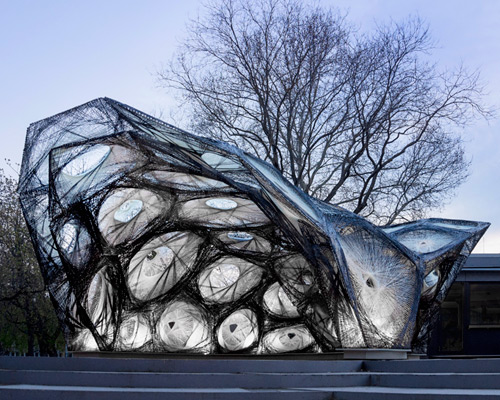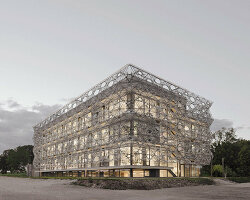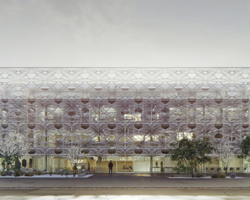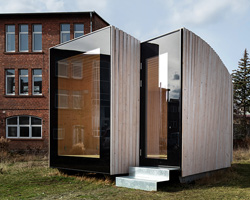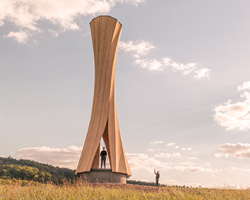interview with ICD/ITKE team on fiber-woven research pavilion 2013-14
photo © ICD/ITKE university of stuttgart
as part of an ongoing series of experimental full-scale projects, the institute for computational design (ICD) and the institute of building structures and structural design (ITKE) at the university of stuttgart have realized a structure made of woven fibers for their 2013-2014 research pavilion. the collaborative studio is invested in exploring the potentials of digital fabrication methods, as well as looking to biological processes for novel and efficient design strategies. specifically, the team worked with biologists to investigate the shells of beetles, in order to develop a light weight panelized canopy form. this process was streamlined with the use of parametric modeling and computer simulation tools. the pavilion’s construction involved two large KUKA robots working together to wind glass and carbon fibers around the thin steel frames.
for a thorough explanation of the project’s design and fabrication, designboom has spoken with the ICD/ITKE research team. research associate moritz dörstelmann describes the institute’s experimental aims, their position within the field of architecture, the unique qualities of this year’s pavilion, and future expectations for ICD/ITKE projects. read on for the full interview.
video courtesy of ICD
designboom: what is the overall aim of the ICD/ITKE research pavilions?
moritz dörstelmann: in the history of architecture, pavilions have often served as case studies for new design concepts, fabrication processes, and material systems. similarly, the ICD/ITKE research pavilions are demonstrators for novel computational design and robotic fabrication strategies. the overall aim is to expand the architectural design repertoire and increase its performative capacity regarding functional integration and material efficiency. such an exploration of new architectural possibilites is possible through the very prototypical and experimental character of the ICD/ITKE research pavilion projects. as a first prototype each research pavilion allows further speculation about application scenarios and future requirements. this opens up new fields of research and potentially leads to fully developed building systems and related design and fabrication processes. such a development can be exemplary seen at the landesgartenschau exhibition hall, which is a direct follow up project of the ICD/ITKE research pavilion 2011. similar opportunities for architectural applications start to arise for design and fabrication processes of fiber composite structures that were and are currently developed at the ICD.
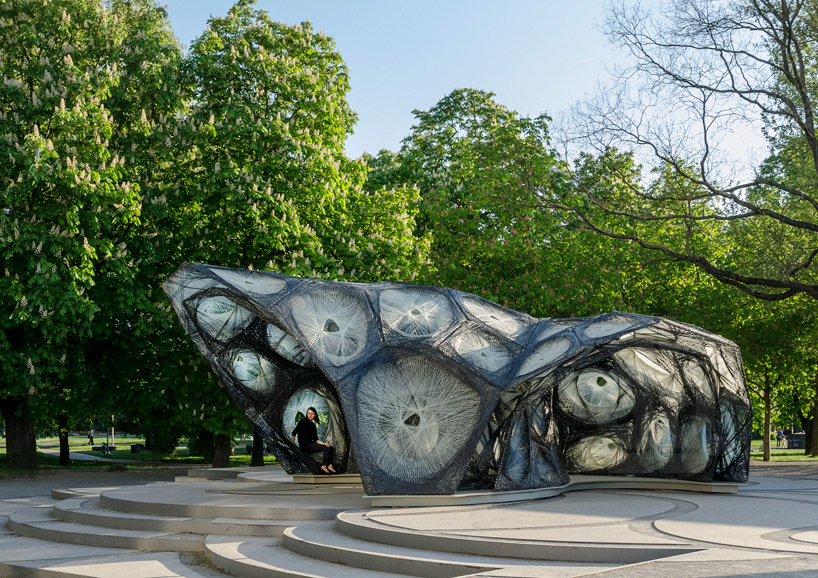
the pavilion opens on either side to create a bending shell form
photo © ICD/ITKE university of stuttgart
DB: what aspects does this pavilion build upon or borrow from prior projects?
MD: all research pavilions are based on a design methodology which employs computational processes of morphogenesis to synthesize multiple design criteria e.g. fabrication process, material behavior, and structural performance into architectural form, while allowing for exploration of architectural design solutions and spatial qualities. in the same way, an integrative computational design tool was developed for the ICD/ITKE research pavilion 2013-14 that informed the design process through integration of biomimetic construction principles, constraints, and possibilities of the robotic filament winding process, material characteristics, and structural performance while still being applicable to a wide range of architectural application scenarios.
regarding the material system there is a clear continuation of the institute’s research interest in fiber composite systems, which resulted in a first larger prototype in the ICD/ITKE research pavilion 2012 and was further explored in the ICD/ITKE research pavilion 2013-14. especially the developed understanding for material characteristics of fiber reinforced polymers and suitable methods of fabrication, which make best use of anisotropic material characteristics led to an expertise in robotic fabrication of fiber composite structures. this constituted a solid knowledge base for the construction of the ICD/ITKE research pavilion 2013-14 and ongoing research and teaching at the ICD.
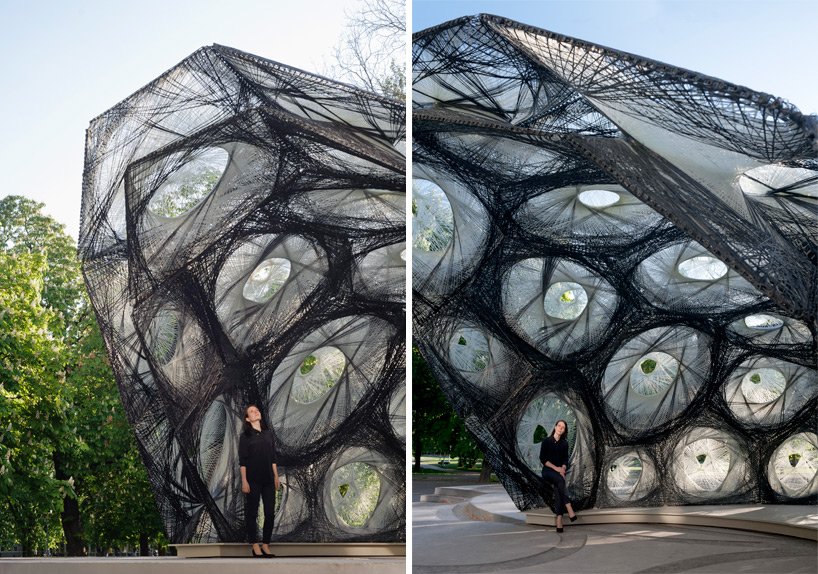
glass and carbon fibers are woven around light steel frames to create each unique panel
photo © ICD/ITKE university of stuttgart
DB: because the pavilion joins a series of experimental projects carried out by ICD/ITKE what makes this structure particularly new and novel?
MD: while on-site fabrication methods for continuous monocoque shells were investigated through the ICD/ITKE 2012 research pavilion, the 2013-14 research pavilion explores the design and fabrication process for segmented fiber composite shells. this allows for the prefabrication of parts within a constant environment that are transportable and can be joined into large and wide spanning structures. compared to the pavilion in 2012, which tested the limits in lightweight construction, the ICD/ITKE research pavilion 2013-14 aimed towards a robust double layered construction that accounts for potential extra loading through a façade system, insulation or other technical installations while still being extremely material efficient. the coreless filament winding technique of the ICD/ITKE research pavilion 2012 reduced the required mold to a minimal steel frame compared to usual industrial winding techniques. this resource efficient method was further explored through the development of a dual robot setup equipped with a reconfigurable robot tool that allowed all 36 geometrically different fiber composite parts to be produced on the same tool.
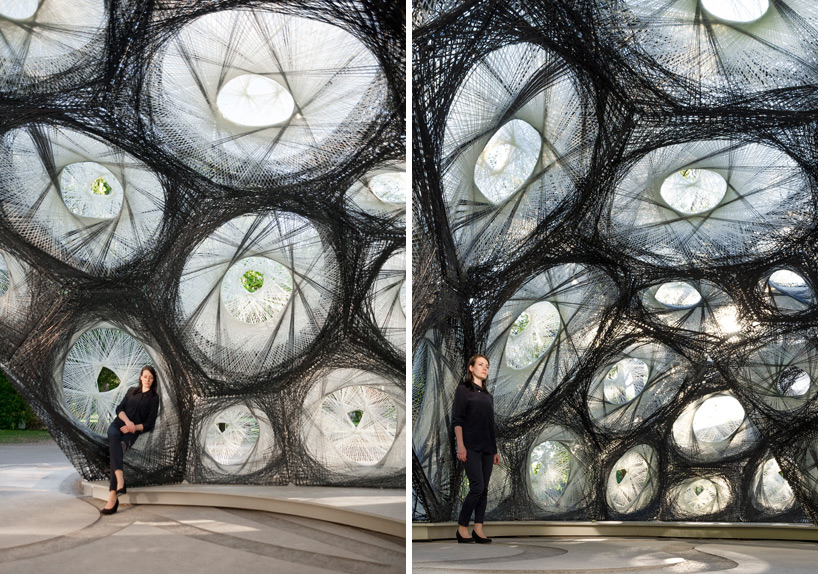
separate light weight panels are attached to create the overall structure
photo © ICD/ITKE university of stuttgart
DB: with software and fabrication developments, is there anything about the pavilion that would not have been attainable in past years?
MD: the research pavilions are developed within the context of a paradigm shift in architectural design and fabrication, which facilitates the implementation of novel design and construction concepts that were previously not feasible. each ICD/ITKE research pavilion achieves its unique architectural solution through material experimentation, the development of custom computational design tools, and novel fabrication concepts. it is often the transfer and combination of existing technologies from adjacent disciplines into architectural applications which open up the potential to explore such new processes.
fiber composite materials have been used in high performance engineering applications since the 1930s. in a similar manner robotic fabrication has been widely used in production automatization. it is the combination of both and its application in conjunction with integrative design computation that allows for automated resource efficient fabrication of one-off fiber composite parts. the fiber composite parts produced for the ICD/ITKE research pavilion 2013-14 are highly differentiated in their geometrical articulation as well as material organization, and thereby allow for a construction principle that achieves a new level of material efficiency in architectural construction that has not been attainable before. at the same time the application of new design and fabrication processes are not only performance driven, but also open up a new architectural repertoire regarding spatial quality, structural articulation, and level of detail.
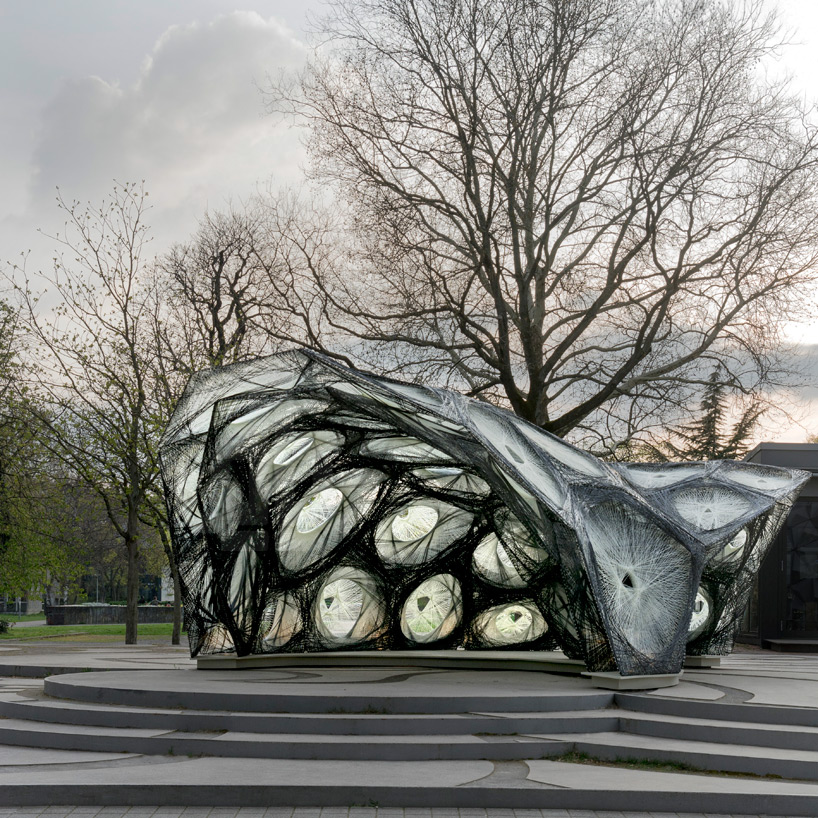
the structure sits upon a thin pediment
photo © ICD/ITKE university of stuttgart
DB: how do architecture and fabrication improve when influenced by biomimetic processes?
MD: natural structures fulfill elementary architectural tasks, like materialization of form and adaptation to external stimuli. similarly to the architectural design and production process, various functional and form generative aspects have to be integrated. although the requirements seem to be similar, natural structures are characterized by a higher level of material efficiency and functional integration than can be found in current building construction. in both cases the result is largely influenced by the underlying processes, but the paradigms are entirely different. while architectural construction is mainly based on addition of standardized elements, natural structures are based on morphogenesis and growth. this allows energy and material efficient solutions to evolve, which are mainly based on complex geometries and differentiated material organization. these performative morphologies in nature as well as their underlying processes of formation are highly interesting as role models for architectural applications. however these cannot be immediately applied to architectural design and construction but require a process of biomimetic investigation to gain a deeper understanding of the underlying functional principles which then can be abstracted and transferred into a technical application. biomimetic investigations have been conducted for several decades, but their translation into technical applications has often been prevented through fabrication processes that were not suitable to implement functional features of natural structures as they often require geometric complexity and hierarchical material organization.
it is the previously described paradigm shift in design and fabrication that allows for the implementation of abstracted principles of natural constructions in building applications. computational design and digital fabrication techniques facilitate the transfer of the underlying functional principles that ensure material efficiency, adaptability, and robustness in natural constructions into architecture. especially the transfer of anisotropic material organization strategies which can be found in most natural constructions and play an important role in their material efficiency become feasible through robotic fabrication of differentiated fiber composite parts.
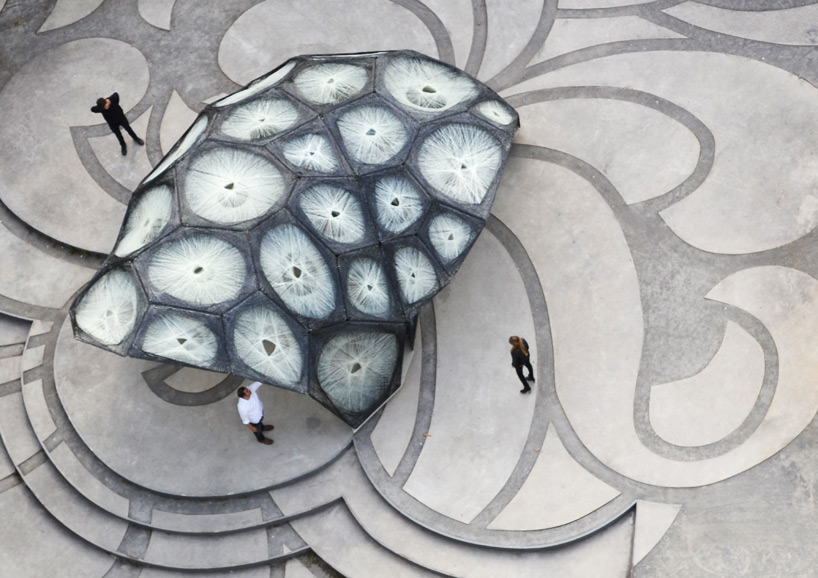
the pavilion’s design is informed by the structure of beetles’ shells
photo © ICD/ITKE university of stuttgart
DB: what significance do biological and biomimetic systems have on the 2013-14 pavilion’s design?
MD: the design process of the ICD/ITKE research pavilion 2013-14 was characterized by a parallel bottom up investigation of robotic fabrication strategies and functional morphology in biological role models. therefore, functional principles of natural lightweight structures were analyzed and abstracted. through the development of a custom robotic fabrication method, these principles were transferred into a modular prototype pavilion.
during the investigation, the elytron, a protective shell for beetles’ wings and abdomen, has proved to be a suitable role model for highly material efficient construction. the performance of these lightweight structures relies on the geometric morphology of a double layered system and the mechanical properties of the natural fiber composite. the anisotropic characteristic of this material, which consists of chitin fibers embedded in a protein matrix, allows for locally differentiated material properties. the elytra morphology is based on a double layered structure which is connected by column-like doubly curved support elements, the trabeculae. the fiber layout within a trabecula merges the upper and lower shell segments with continuous fibers. the distribution and geometric articulation of the trabecula is highly differentiated throughout the beetle shell. through comparative studies of multiple flying beetle species the underlying structural principles could be identified and translated into design rules for structural morphologies.
based on the differentiated trabeculae morphology and the individual fiber arrangements, a double layered modular system was generated for implementation in an architectural prototype. through the development of computational design and simulation tools, both the robotic fabrication characteristics and the abstracted biomimetic principles could be simultaneously integrated in the design process.
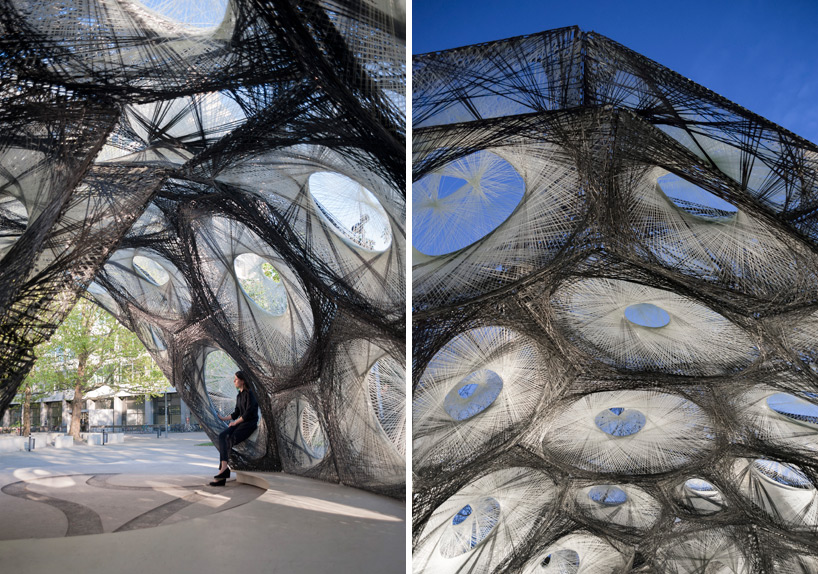
photo © ICD/ITKE university of stuttgart
DB: to what extent did the architecture and engineering team collaborate with biologists and other disciplines?
MD: we think that the field of architecture largely benefits from an intensive exchange of ideas and technologies with other disciplines within collaborative interdisciplinary projects. this expands the role of the architect towards the design of processes and systems that allow a meaningful synthesis of the many contributing fields to architecture. such future developments are reflected in our teaching through the multidisciplinary orientation of our master course: integrative technologies and architectural design research (ITECH). we are currently teaching 32 students from 21 countries with degrees in architecture, structural engineering, computer science, and biology.
one purpose of the ICD/ITKE research pavilions is to establish new cooperations and intensify existing interdisciplinary contacts of the ICD and ITKE. computational design methods play an important role within such multidisciplinary design processes as they are suitable to integrate the input from various fields into the architectural design process and thereby can serve as a point of confluence.
the ICD/ITKE research pavilion 2013-14 was developed in an interdisciplinary cooperation of architects and engineers from stuttgart university, biologists from tubingen university and imaging specialists from the KIT. The project started with an investigation of natural fiber composite structures within the module: bionics of animal constructions led by prof. oliver betz (institute of evolution and ecology, university of tübingen) and prof. james h. nebelsick (dept. for paleobiology, university of tübingen). these investigations were conducted in mixed teams of architecture, biology, and geology students. various construction principles of natural constructions were analyzed, abstracted, and a developed into concepts for architectural applications. the beetle’s elytron was chosen as the most promising role model for further investigation. the in depth analysis of this role model was possible through cooperation with dr. thomas van de kamp from the ANKA synchrotron radiation facility and the institute for photon science and synchrotron radiation at the karlsruhe institute of technology (KIT), where high resolution 3D models of various beetle elytra were extracted through micro-computed tomography. together with SEM scans from the university of tübingen, this enabled an analysis of the intricate internal structures of the beetle shell.
the transfer into technological application was supported by industry partners (KUKA Roboter GmbH) and engineering institutes of the university of stuttgart (institute for machine tools, institute of textile technology and process engineering, institute of aircraft design). these cooperations played a vital role within the project that would not have been possible without the extensive collaborations across various disciplines.
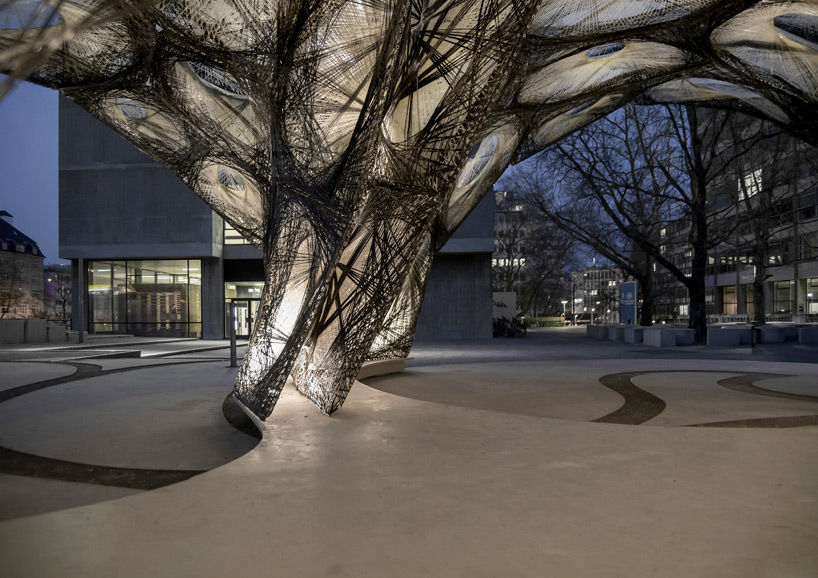
each panel is made of and inner and outer layer
photo © ICD/ITKE university of stuttgart
DB: what concepts or techniques do you envision ICD/ITKE will investigate in the future?
MD: the multidisciplinary research and the close cooperation of the ICD and ITKE will be continued within the recently acquired collaborative research center TRR 141 ‘biological design and integrative structures’. under the guidance of prof. jan knippers and prof. achim menges as principal investigators, various interdisciplinary research projects will focus on the analysis and abstraction of design and construction principles in nature and their implementation in architecture.
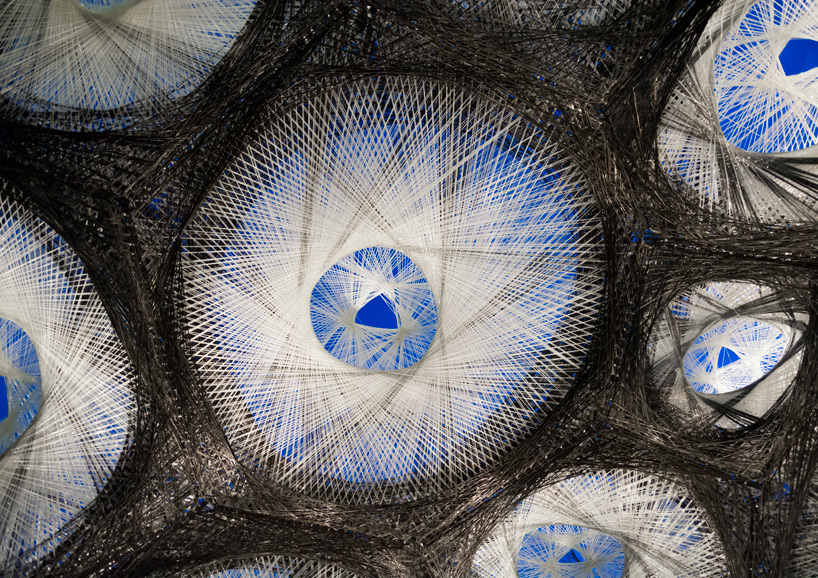
the fiber patterning is arranged around an open aperture
photo © ICD/ITKE university of stuttgart
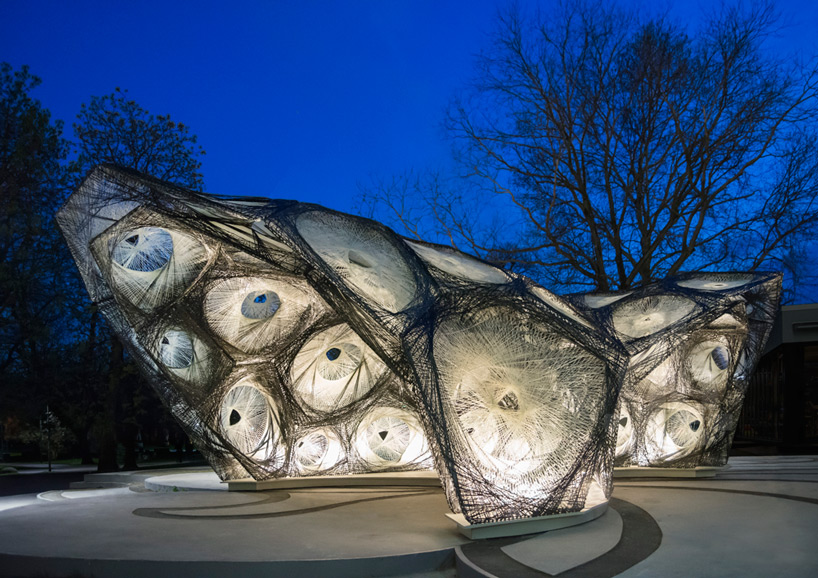
photo © ICD/ITKE university of stuttgart
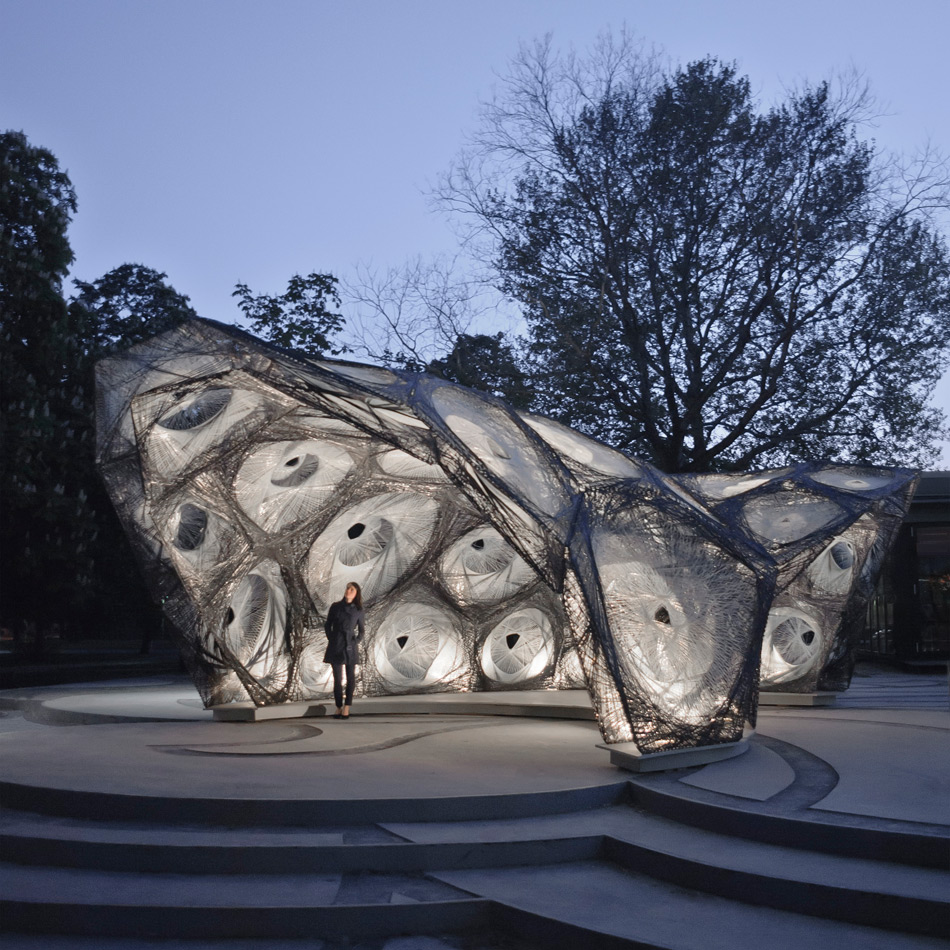
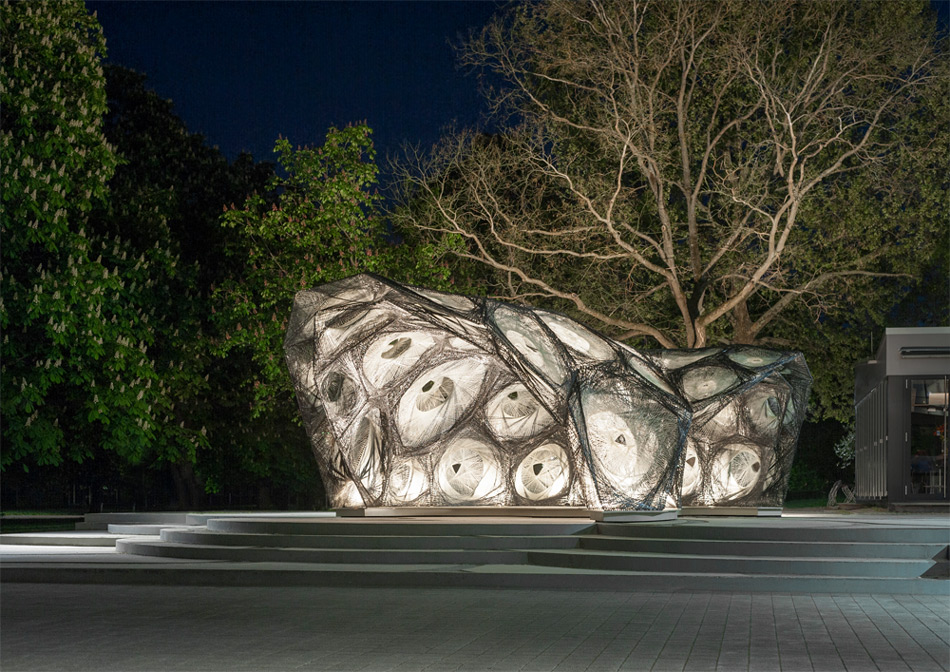
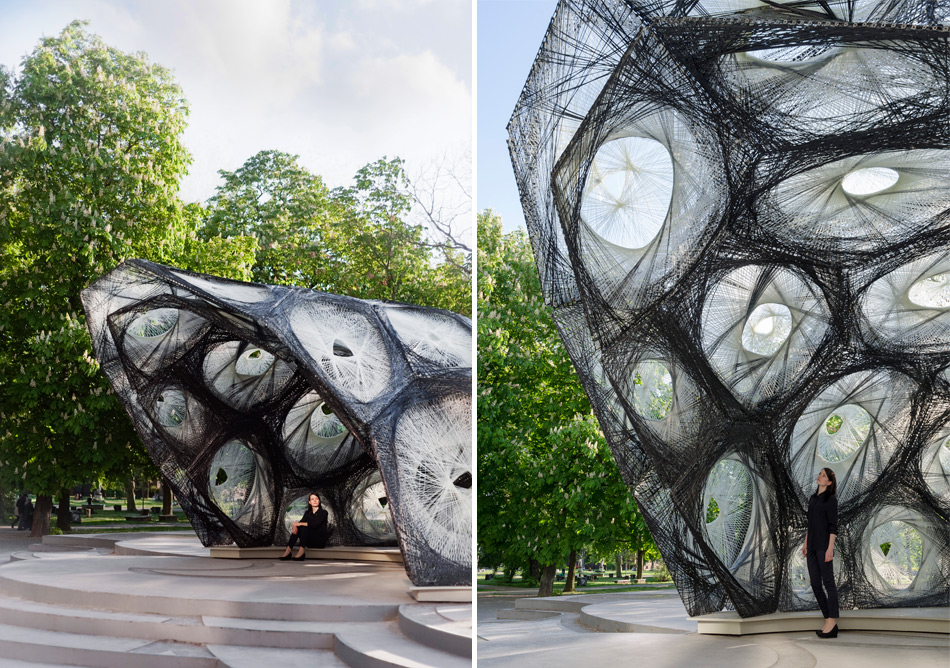

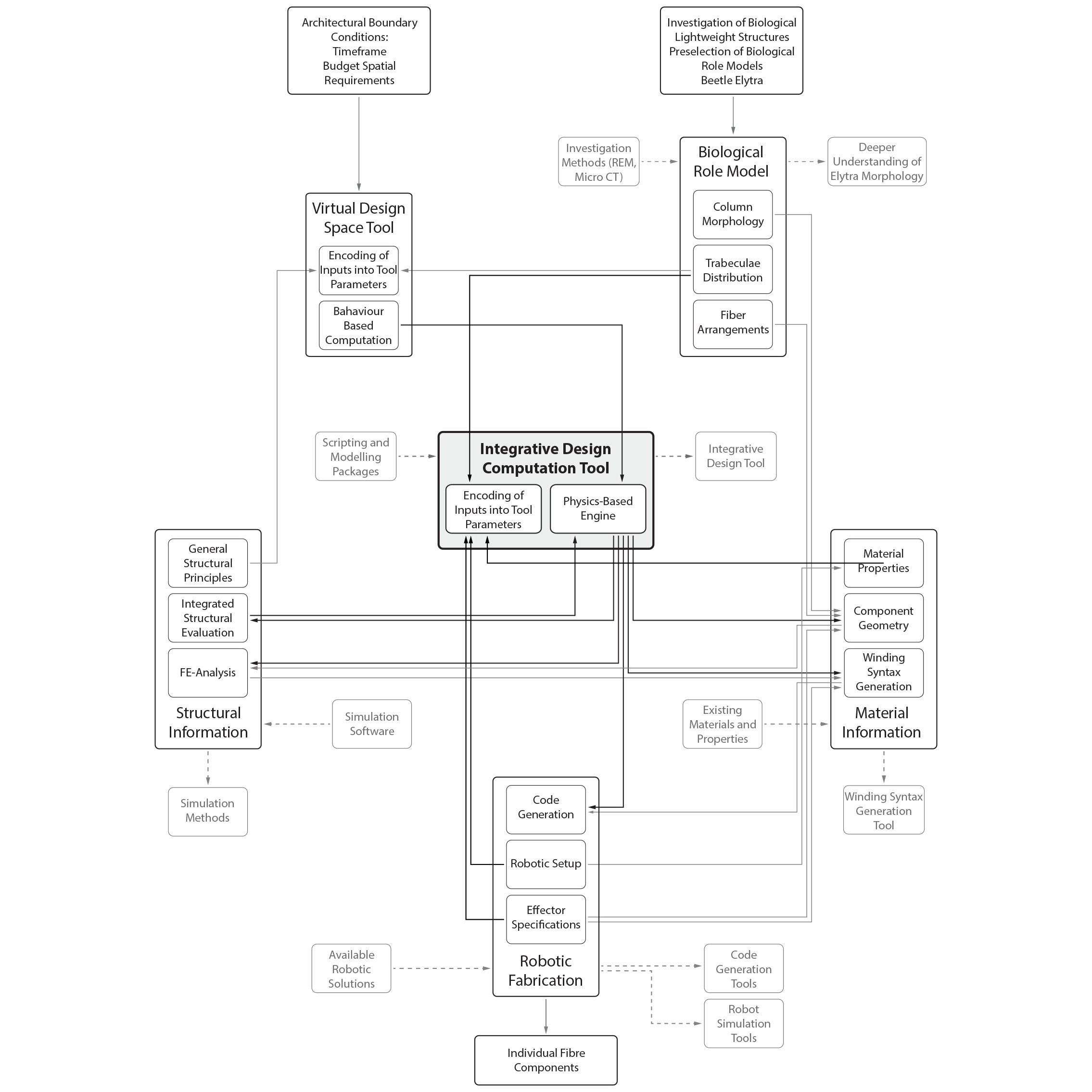

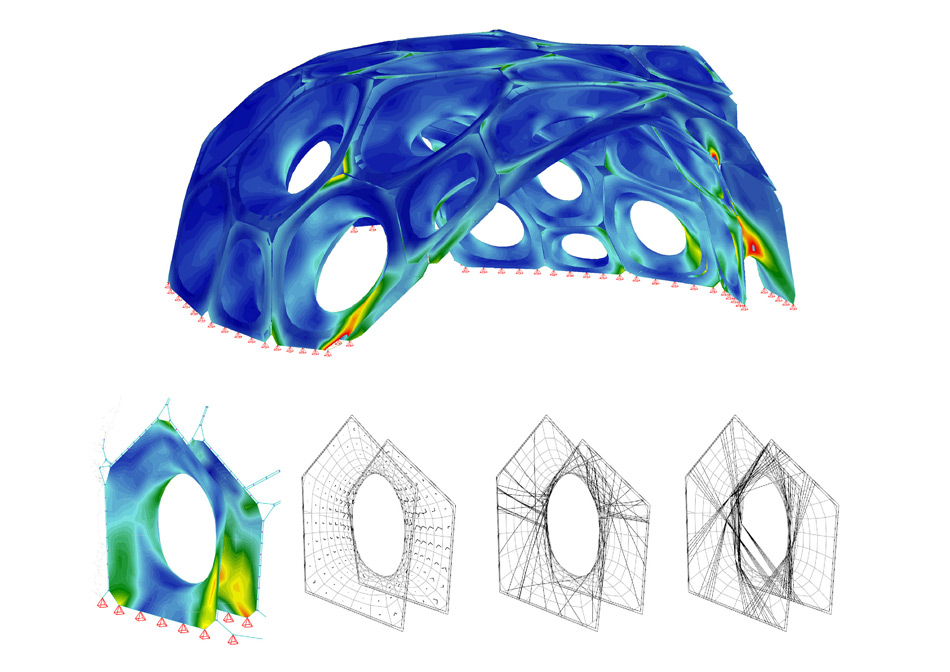



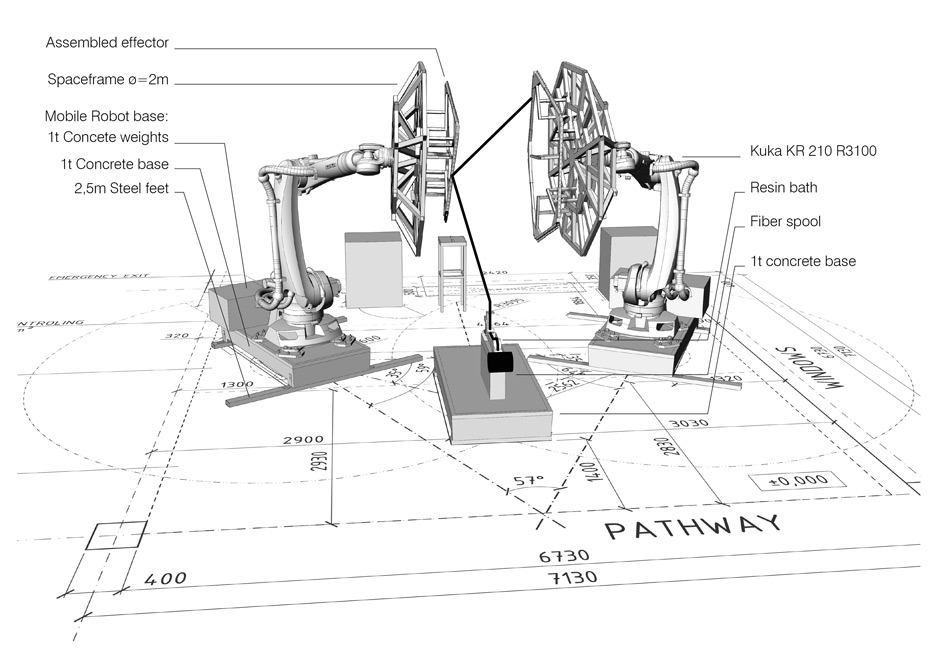
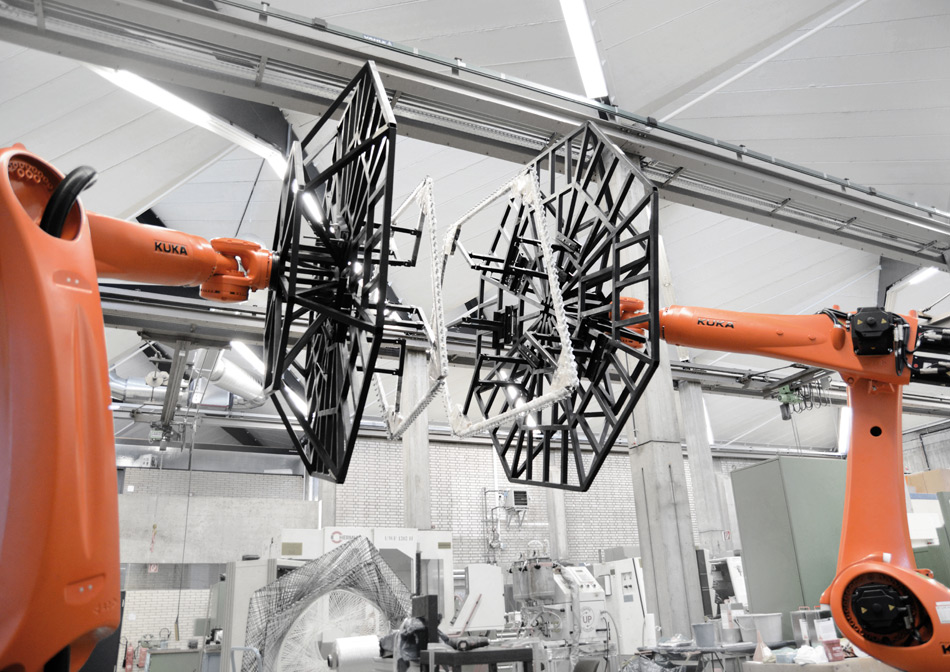
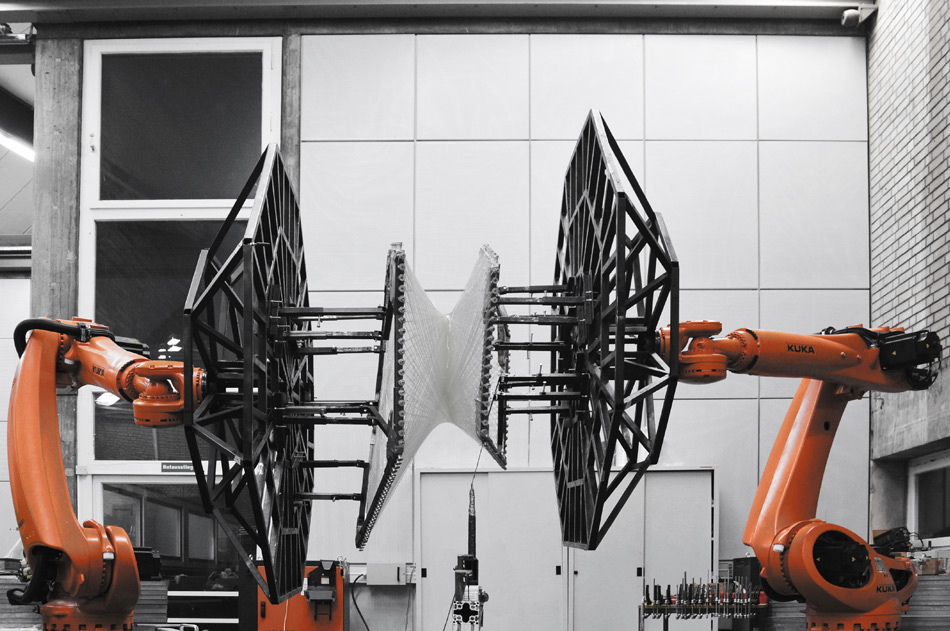
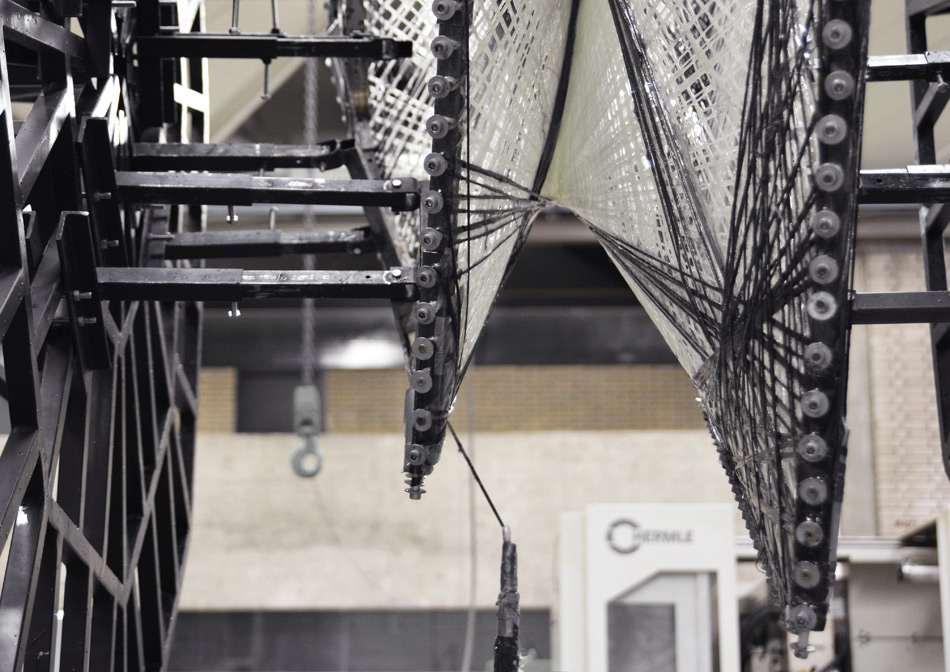
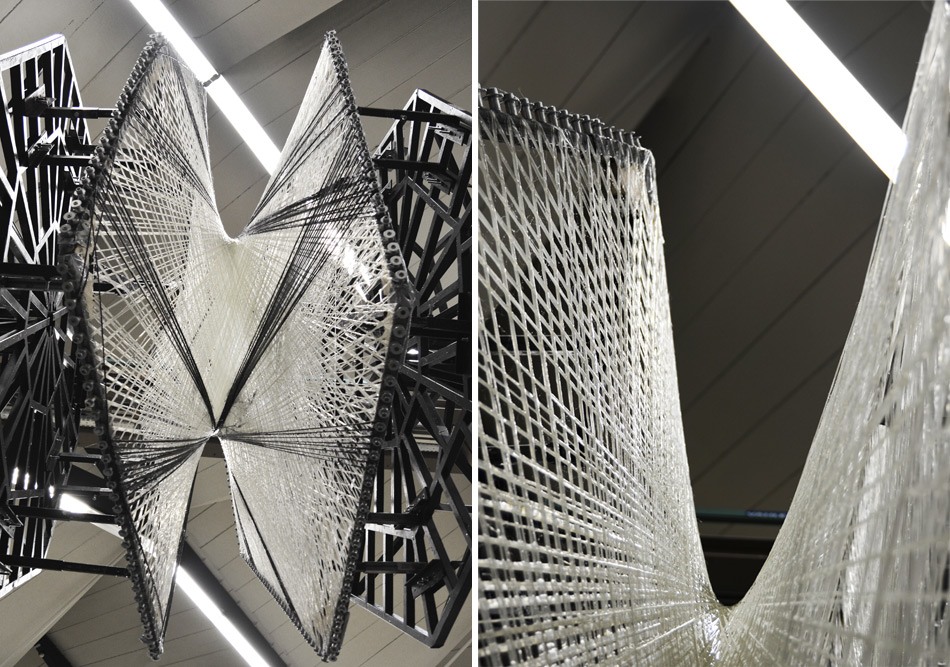
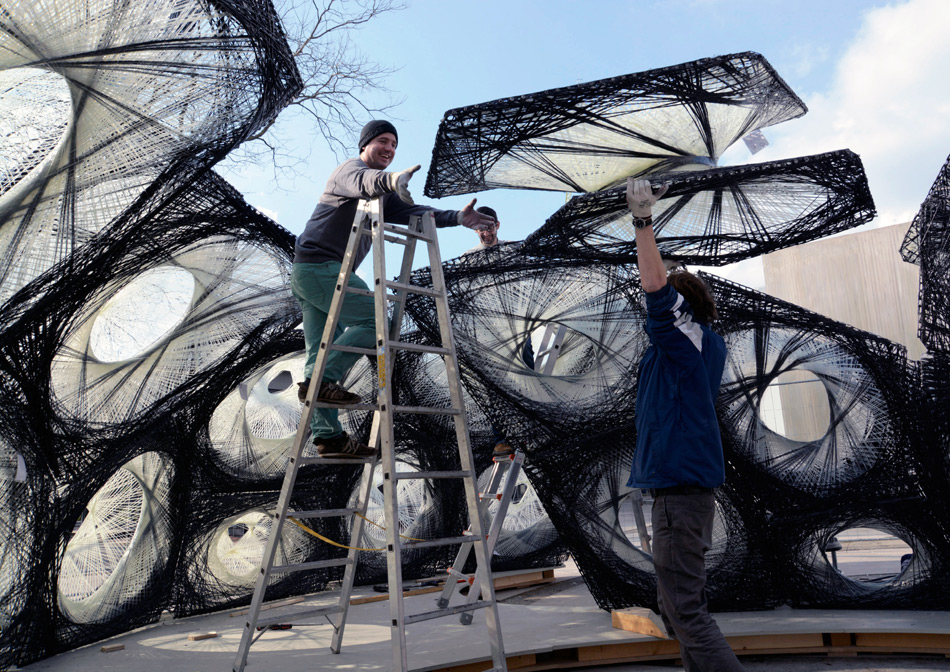
project info:
completion: march 2014
area: 50 sqm
volume: 122 cbm
credits:
institute for computational design: prof. achim menges
institute of building structures and structural design: prof. jan knippers
research development and project management: moritz dörstelmann, vassilios kirtzakis, stefana parascho, marshall prado, tobias schwinn
concept development: leyla yunis
system development, fabrication + construction:
wise 2012 – sose2013: desislava angelova, hans-christian bäcker, maximilian fichter, eugen grass, michael herrick, nam hoang, alejandro jaramillo, norbert jundt, taichi kuma, ondrej kyjánek, sophia leistner, luca menghini, claire milnes, martin nautrup, gergana rusenova, petar trassiev , sascha vallon, shiyu wie
wise 2013: hassan abbasi, yassmin al-khasawneh, desislava angelova, yuliya baranovskaya, marta besalu, giulio brugnaro, elena chiridnik, eva espuny, matthias helmreich, julian höll, shim karmin, georgi kazlachev, sebastian kröner, vangel kukov, david leon, stephen maher, amanda moore, paul poinet, roland sandoval, emily scoones, djordje stanojevic, andrei stoiculescu, kenryo takahashi, maria yablonina supported by michael preisack
